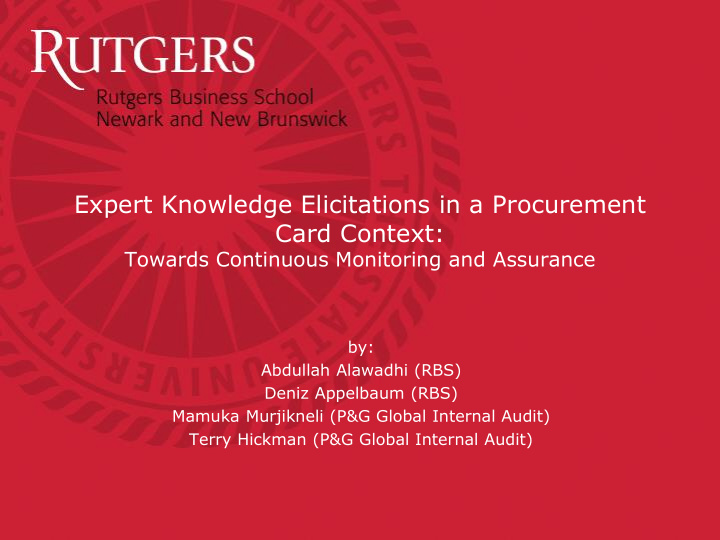



Expert Knowledge Elicitations in a Procurement Card Context: Towards Continuous Monitoring and Assurance by: Abdullah Alawadhi (RBS) Deniz Appelbaum (RBS) Mamuka Murjikneli (P&G Global Internal Audit) Terry Hickman (P&G Global Internal Audit)
AGENDA • INTRODUCTION • THE DATA • P-CARD MISUSE DETECTION • MOVING FORWARD • CONCLUSION 2
INTRODUCTION • Why P-card has higher fraud risk than employee credit card? – P-card owners have a higher number of transactions on a normal basis, while employee credit card usage is typically linked to event or a business trip. – For P-card transactions, no pre-approval is required, while normally employee credit card transactions need to be approved by the manager before AMEX gets reimbursed. – Values involved are higher due to type of goods/services purchased, which drives pressure to commit fraud. – Difficulty to detect misuse increases opportunity, which, together with the pressure, constitute two out of three fraud triangle factors. 3
INTRODUCTION • P&G’s team currently analyzes pro card data for misuse manually, hence the desire to design a system that would automate the process • Main objective: – The elicitation of an expert’s knowledge by conducting unstructured interviews and ultimately build an expert system to detect p-card misuse 4
THE DATA • The data file obtained details every transaction from the preceding month of employee p-card use, and averages about 50,000 transactions with 51 attributes • Data obtained is monthly 2013 data starting from April till July • Some of the data fields have missing values 5
P-CARD MISUSE DETECTION - Analysis • Firm's Procurement Process Purchase is P-Card team copied from the Manager marks downloads all Cardholder bank’s credit transactions transactions and makes purchase system and The bank is paid reviewed or uploads for with P-Card posted to the requests more management information. firm’s ERP review system • Auditor’s Monitoring Process Auditor manually Auditor marks red Auditor obtains HR will follow up and reviews P-Card flagged transactions monthly list of P-Card send feedback to transactions for any and submits them to transactions Auditor suspected red flags HR 6
P-CARD MISUSE DETECTION - Analysis • The project requires elicitation of an expert’s knowledge Data and Project Unstructured Interviews Preparation of First Pass Analysis Test • Gains more knowledge from the experts • Familiarity with data and • Beginnings of project file project requirements • Yields enough information • Continual refinement of for first pass test data base • Analysis of texts and rules based scripts documents; exploratory tests Special Tasks Preparation of Second More Interviews Pass Tests • Yields continued • Unstructured and refinements to the system, • Refinement of the test file Structured continuous methodology • Results of file scripts • Yields enough information compared to those of the for second pass tests control, the expert's knowledge 7
P-CARD MISUSE DETECTION - Results • First test was textual analytics. By having certain keywords marked as inappropriate, we were able to filter those out. • One case (highlighted in red) identified immediately as fraudulent by the company 8
P-CARD MISUSE DETECTION - Results • One of the main challenges of this project was of designing an expert knowledge system where a key data field, such as purchased item description, is missing • For example, a major vendor opts to not provide any item description information. – Management needs to put more consideration in such cases were the opportunity to commit fraud is more apparent 9
P-CARD MISUSE DETECTION - Results • Examples of some rules used: IF [MCH_Merchant_Category_Code] EQUAL 4900 AND [MCH_Merchant_Name ] NOT EQUAL “Waste Management” OR “Suburban Propane” AND [Department_Cost_Center] OR [Department_Name] CONTAINS “PLANT” OR “Manufacturing” OR “BUILDINGS/GROUNDS” THEN FAIL IF [MCH_Merchant_Category_Code] EQUAL (RANGE:7829-7999) AND [Department_Name] NOT EQUAL “NATIONAL GOVERNMENT RELATIONS” AND [MCH_Merchant_Name] NOT EQUAL “CAPITOL HILL CLUB” THEN FAIL 10
P-CARD MISUSE DETECTION - Results • Over the last few months the system detected three fraudulent cases during the testing phases alone • The initial first run of the expert system produce a total of 1408 exceptions • After reviewing the exceptions with the experts, 68% were considered legitimate red flags and would require further investigation 11
MOVING FORWARD • Further refine rules with the experts, and run the system on new data • Building user purchase behaviors by applying pattern recognition and utilizing visualization scenarios to assist in outlier detection. • Higher risk factors will be assigned to: – Certain predefined types of pattern changes. – Differences in individual purchase patterns vs. the cluster aggregate. 12
MOVING FORWARD • Examples of some visualization scenarios we created to help in building user purchase behaviors: • The most heat (color) intensity among the states goes to Ohio, i.e. it has 64% of the total dollar amounts spent. 13
MOVING FORWARD • By aggregating dollar amounts per transaction for both merchants and employees, we can further understand the data and be able to build better purchase patterns 1,106 Transactions Only 8 Transactions • One example here is employee T2472, were despite being third place in terms of total dollar spending ($424,879), has only 8 records in total 14
CONCLUSION • The project is still a work in process, primarily due to the complexity of rules and transactions that must be gleaned in this outlier detection process • Furthermore, these tests can be applied on a continual basis, contributing to the continual journey of expert knowledge elicitation in a continuous auditing and monitoring environment • Moving forward we plan on applying different analytics for misuse detection such as building user purchase behaviors 15
16
Recommend
More recommend